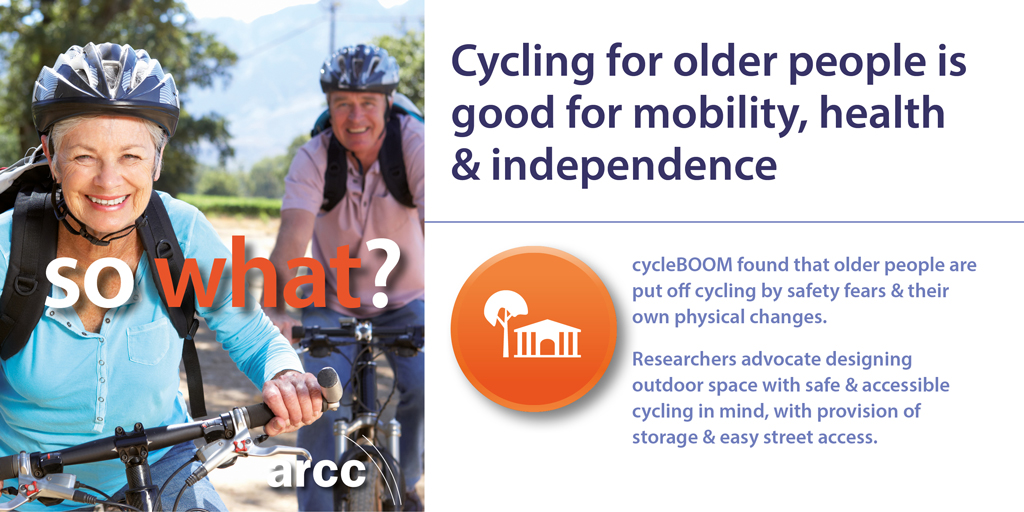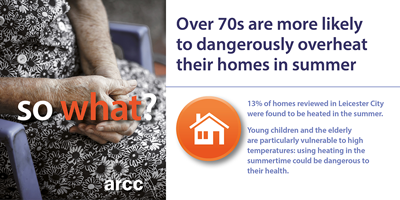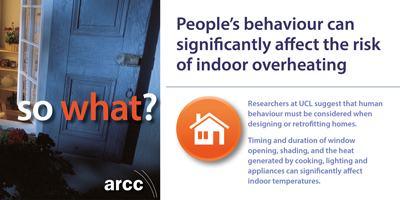Health & wellbeing
The changing climate will have significant impacts on people’s health and wellbeing. Increasing temperatures and more frequent and severe extreme weather events are projected to affect the health and wellbeing of individuals as well as the broader community, with consequences for public health and social care services.
The failure of buildings and infrastructure as a result of extreme weather events will have an indirect effect on our health and wellbeing, as well as impacts on service provision, productivity and the economy.
Groups such as the elderly, very young and those with existing health issues will be more vulnerable, particularly to extreme heat. Summertime overheating will be a challenge for those spending long periods in hospital or living in urban heat island affected areas.
Heatwaves can also result in increased air pollution, particularly in urban areas, leading to respiratory or inflammatory problems for vulnerable people.
The effects of a changing climate on health and wellbeing will vary across the UK, and will influence, and be influenced by, impacts and adaptation measures in other sectors.
The Climate Change Risk Assessment (CCRA) 2017 indicates the need for more research on the influence of climate change on outdoor air pollutants and vector-borne pathogens. The report also comments on inconsistencies in health and social care planning for severe weather events.
Research projects
- BIOPICCC – with an emphasis on the wellbeing of older people, developing locally-relevant adaptation strategies to promote resilient health and social care systems to 2050.
- CREW – at the local level, mapping future extreme weather events such as flooding and heatwaves to help identify where significant adaptations need to be made.
- DeDeRHECC – investigating economical and practical strategies for the adaptation of NHS buildings to ensure sustainable patient care in a changing climate.
- Liveable Cities – delivering global and societal well-being through radical engineering solutions, while adhering to a low-carbon, resource secure future.
- Mobility, Mood and Place – exploring how places can be designed collaboratively to make pedestrian mobility easy, enjoyable and meaningful for older people.
- Retrofitting Resilience – a study and framework to evaluate both current and future flood resilience at a community level.
- SNACC – developing a portfolio of adaptation strategies for suburbs including building-level interventions and broader ideas such as green landscaping to cool the environment.
- Street mobility accessibility – the street mobility project is developing a suite of tools to measure the ‘barrier-effect’ of traffic, or other transport infrastructure, on access to goods, services and people.
- LoHCool – investigating and developing strategies to reduce CO2 emissions from space heating and cooling in typical urban buildings, working in China and the UK.
Outputs in action
- BIOPICCC Toolkit to help local authorities and community groups with local level resilience planning.
- Heatwave Plan for England. Raises public and professional awareness of the effects of severe heat on health. Includes results from CREW on keeping homes cool, and from BIOPICCC and DeDeRHECC on informing strategies to cool hospital estates and care homes.
- CIBSE Building Services Engineering Research & Technology journal special issue: Adaptation and resilience to a changing climate; supporting adaptation decision making. Includes a paper from DeDeRHECC on improving the resilience of hospital wards in a changing climate.
- Symposium – Climate change, risk and resilience: lessons for health and social care(pdf, 670 KB). Includes BIOPICCC and DeDeRHECC contributions when looking at the challenge of health and social care delivery in the future.




